bartender培训教程ppt课件
- 格式:ppt
- 大小:1.07 MB
- 文档页数:53

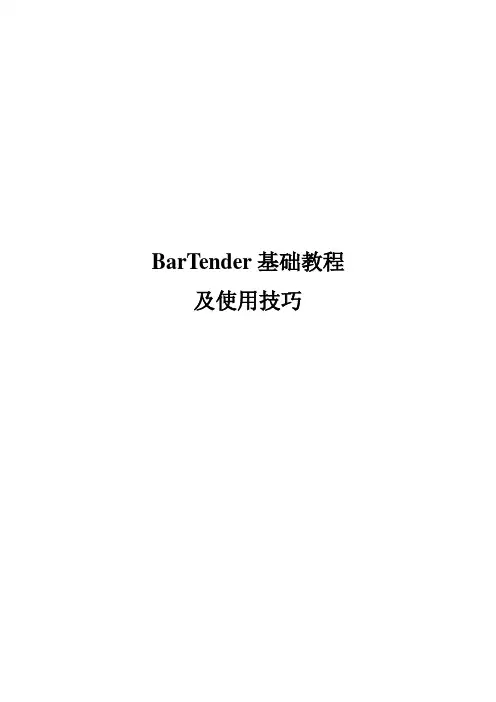
BarTender基础教程及使用技巧目录1 Seagull打印机驱动 (3)1.1 Seagull驱动的优势 (3)1.2 内嵌字体与Windows字体的对比 (3)1.3 如何下载字体到打印机 (3)1.4 如何获取一台电脑的BarTender、打印机以及PC本身的信息 (4)2 简单界面操作 (5)2.1基本的类似Windows的友好操作(拖拽、排列) (5)2.2 组件、自定义工具箱功能 (6)2.3 图像导出 (7)2.4背景设置 (8)3 口令设置 (9)4 数据库和序列打印 (9)4.1 基本的数据库打印以及字体大小自动调整功能 (9)4.2 每条记录得打印数量问题 (12)4.3 查询和SQL功能 (13)4.4 数据库字段---打印数量 (14)4.5 关于文本数据库的打印 (16)4.6 SAP(中间文档)打印 (17)4.7 序列打印 (17)5 子串和共享 (18)5.1 子串的创建 (18)5.2 共享名的使用 (19)6 打印前提示 (20)6.1 简单数据的打印提示 (20)6.2 打印数量的打印前提示 (22)6.3 打印前提示使用技巧(快捷方式的巧用) (24)7 灵活的中间件:Commander (24)7.1 Commander的基本使用 (24)7.2 Commander的启示 (27)8 RFID条码的打印 (27)1 Seagull打印机驱动1.1 Seagull驱动的优势Seagull驱动非常全面,并且随时更新,有时候很多问题本机自带驱动的问题1.2 内嵌字体与Windows字体的对比Seagull有丰富的打印机驱动,支持所有打印机内嵌字体,支持所有条码字体,内嵌字体的好处:速度快,效率高,无须下载Windows字体,以下是调用内嵌字体和Windows 字体的对比:左侧的图是直接调用打印机字体是打印机所接受的打印机指令,右侧的图则是调用Windows字体时所接受的打印机指令,很明显如果调用Windows字体需要经过一个字符集的下载过程,如果要是打印序列或者是同样的标签时,会屡次调用Windows字体,会影响效率。
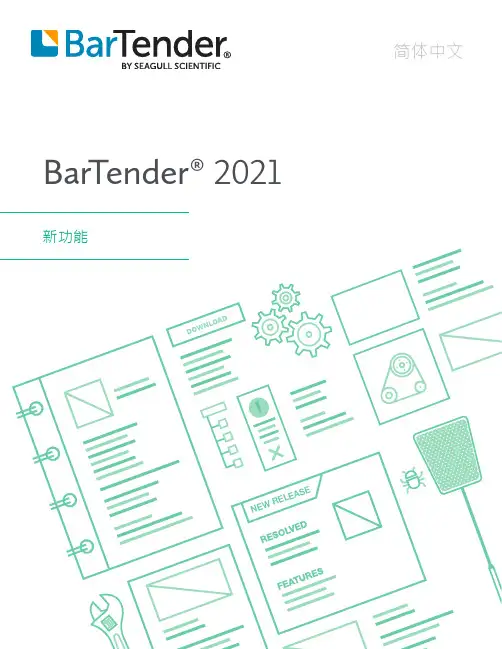
简体中文BarTender® 2021N E W R E LE A SEN E W R E LE A SE目录关于BarTender ....................................................................................................................................................... 新功能及改进功能.. (5)Librarian Workflow Designer (5)为工作流程对象指定权限 (7)为工作流程对象配置电子邮件通知 (8)验证工作流程 (11)配置工作流程规则 (12)在管理控制台中分配Workflow Designer安全等级 (13)Print Portal重新设计版 (14)无驱动打印 (14)工作流改进 (14)安全与身份验证 (15)可用性改进 (16)自定义企业品牌标识 (18)Print Portal集成Librarian (19)性能 (19)支持修订历史和工作流程状态 (19)对librarian工作流程的高级支持 (20)从先前的BarTender工作流程更新 (21)访问工作流程设计设置 (21)支持文件状态和过渡 (21)支持传统工作流程 (22)词库 (23)创建一个词库 (23)为文档添加词库数据源 (25)对Librarian工作流程和Print Portal自动化的扩展API支持 (27)Librarian API更新 (27)Print Portal公共REST API (28)改进的业务连续性和灾难恢复支持 (29)许可服务器冗余 (29)N E W R E LE A SEN E W R E LE A SE受监控数据库的自动重启 (30)扩展数据库选项 (31)新数据库类型 (31)用于文本和XML数据库连接的嵌入式样本数据 (32)其他改进 (32)条形码更新 (33)支持GS1版本20规范 (33)扩展数据库矩阵大小选项 (33)BarTender Designer改进 (33)新的数据源选项 (33)动态嵌入式表格中的图像支持 (34)新的颜色选择器及对 PANTONE®色彩的支持 (35)动态嵌入式表格对象的自动化支持 (36)数据输入表单改进 (37)打印机相关改进 (38)打印对话框选项 (38)支持打印机形状切割 (38)其他改进 (38)用于重新打印的新注释属性 (39)关闭打印机重定向的选项 (39)安全改进 (40)用户权限模板 (40)改进的加密密钥管理 (41)集成消息记录 (42)操作相关改进 (43)改进的While Loop操作 (43)“打印批操作”更名为“BarTender进程” (44)PowerShell脚本编辑器 (44)相关文档 (45)技术文档 (45)手册 (45)BarTender帮助系统 (45)其他资源 (45)关于BarTender 2021借助Seagull Scientific (海鸥科技)的BarTender®软件,全球各组织可以通过创建及自动进行标签、条形码、RFID 标签、塑料卡等的打印来提高安全、保障、效率及合规性。
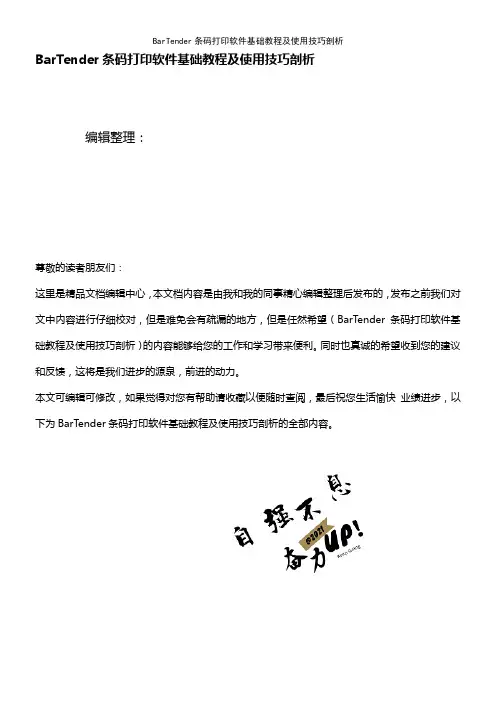
BarTender条码打印软件基础教程及使用技巧剖析编辑整理:尊敬的读者朋友们:这里是精品文档编辑中心,本文档内容是由我和我的同事精心编辑整理后发布的,发布之前我们对文中内容进行仔细校对,但是难免会有疏漏的地方,但是任然希望(BarTender条码打印软件基础教程及使用技巧剖析)的内容能够给您的工作和学习带来便利。
同时也真诚的希望收到您的建议和反馈,这将是我们进步的源泉,前进的动力。
本文可编辑可修改,如果觉得对您有帮助请收藏以便随时查阅,最后祝您生活愉快业绩进步,以下为BarTender条码打印软件基础教程及使用技巧剖析的全部内容。
BarTender条码打印软件基础教程及使用技巧厦门远景达目录1 Seagull打印机驱动 (5)1.1 Seagull驱动的优势 (5)1。
2 内嵌字体与Windows字体的对比 (5)1.3 如何下载字体到打印机 (6)1.4 如何获取一台电脑的BarTender、打印机以及PC本身的信息 . 62 简单界面操作 (7)2.1基本的类似Windows的友好操作(拖拽、排列) (7)2.2 组件、自定义工具箱功能 (8)2。
3 图像导出 (9)2.4背景设置 (10)3 口令设置 (11)4 数据库和序列打印 (11)4.1 基本的数据库打印以及字体大小自动调整功能 (11)4.2 每条记录得打印数量问题 (14)4。
3 查询和SQL功能 (15)4。
4 数据库字段-—-打印数量 (16)4。
5 关于文本数据库的打印 (18)4。
6 SAP(中间文档)打印 (19)4。
7 序列打印 (19)5 子串和共享 (20)5.1 子串的创建 (20)5.2 共享名的使用 (21)6 打印前提示 (22)6。
1 简单数据的打印提示 (22)6.2 打印数量的打印前提示 (24)6。
3 打印前提示使用技巧(快捷方式的巧用) (26)7 灵活的中间件:Commander (27)7.1 Commander的基本使用 (27)7.2 Commander的启示 (30)8 RFID条码的打印 (30)1 Seagull打印机驱动1.1 Seagull驱动的优势Seagull驱动非常全面,并且随时更新,有时候很多问题本机自带驱动的问题1。
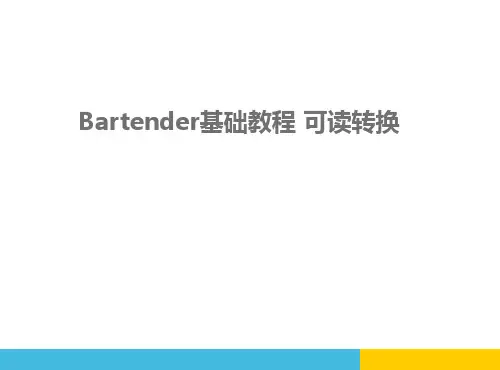
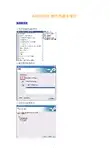
BARTENDER 软件的基本使用标签的设置1.先启动BarTender软件。
2.建立新的标签格式。
3.选择空白标签格式。
4.选择安装完成的打印机型号。
5.如没有合适的标签格式,选择自定义设置。
6.根据实际的标签样式,选择标签格式。
例如一排上有三张小标签,那么选择第二项,行数为:1,列数为:3。
单排的就选第一项。
7.请注意标签的边缘宽度数值。
8.请选择标签的形状。
9.定义标签的实际大小值。
可以通过右侧预览查看形状。
10.完成后显示一空白标签,且屏幕上的鼠标光标应该处于指针模式(形状象一个箭头)。
标签内容的编辑创建条形码或文本对象1. 单击主工具栏上的创建条形码按钮或创建文本按钮,单击的按钮取决于要创建条形码还是文本区域(称为“文本对象”)。
2. 将光标移动到标签视图区域中,单击对象中心应处的位置。
注:还可以使用BarTender 工具箱在标签中添加对象。
请参阅下文的BarTender 工具箱。
选择或取消选择对象要选择对象,只需单击该对象。
对象被选中后,将有八个实心手柄,每个边角一个,四条边线每条边线的中点一个,用于调整对象的大小。
单击对象外面的任意位置可以取消选择。
移动标签对象要在标签视图区域中更改一个对象的位置,最简单的方法是使用鼠标单击并将其拖动到一个新的位置。
关于如何将对象从一种标签格式移动到另一种标签格式。
拉伸对象和调整对象大小若要调整标签对象的大小,请单击以选中标签对象,然后拖曳对象边线上出现的小方形手柄中的一个。
1. 选中对象,并将指针光标置于四个边角把手中的一个,以便同时更改高度和宽度。
如果只需要调整一个方向的尺寸,将指针置于边线把手中的一个。
如果光标的位置正确,将变为一个双向细箭头。
2. 单击并拖曳所选的把手,直到对象达到所需的尺寸。
使用单击和拖曳也可以单击对象并将对象拖曳到标签格式的新位置。
这样做时如果按住Ctrl 键,将在新位置创建一个副本。
最后,还可以右键单击并拖曳到所需的位置。
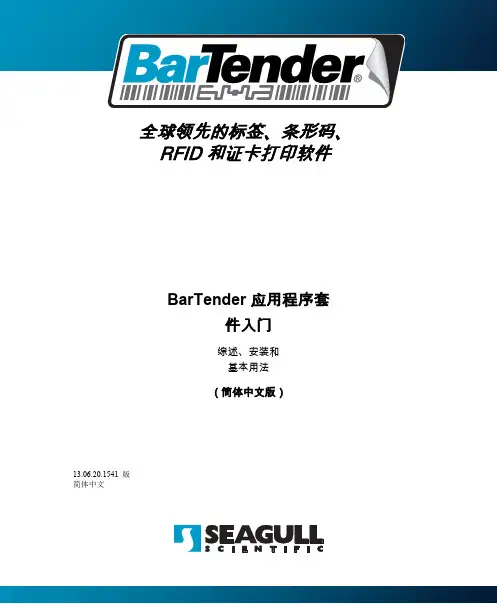
13.06.20.1541版简体中文全球领先的标签、条形码、RFID 和证卡打印软件BarTender 应用程序套件入门综述、安装和基本用法(简体中文版)© Copyright Seagull Scientific, Inc. 2001-2013. All rights reserved.Information in this document is subject to change without notice. No part of the publication may be reproduced, transmitted, transcribed, stored in a retrieval system, or translated into any language in any form or by any means without the written permission of Seagull Scientific, Inc. HASP® is a registered trademark of Aladdin Knowledge Systems, Ltd.Windows and the Windows logo are trademarks of the Microsoft group of companies.SQL Server™ is a trademark, of Microsoft Corporation.Oracle® is a registered trademark of Oracle Corporation.SAP™ is a trademark of SAP Aktiengesellschaft.The Ready for IBM Websphere software mark and the trademarks contained therein are trademarks of IBM Corp. IBM is not the licensor of this Business Partner's product and does not make any warranties regarding this Business Partner's product.BarTender® is a registered trademark of Seagull Scientific, Inc.All other registered names and trademarks referred to in this manual are the property of their respective companies.第一章:BarTender 应用程序套件导言 (1)概述 (1)BarTender (1)Drivers by Seagull (2)集成 (2)Commander (3)BarTender .NET SDK (3)系统管理 (4)BarTender Security Center (4)Printer Maestro (5)Librarian (6)History Explorer(历史记录浏览器) (6)Seagull License Server (7)System Database Setup (7)打印实用工具 (8)Web Print Server (8)Reprint Console(重印控制台) (9)Print Station (9)Batch Maker (10)第二章:安装与激活 (11)安装 BarTender 应用程序套件 (11)基本版和专业版的预安装规划 (11)自动化版的预安装规划 (11)安装步骤 (12)安装 BarTender System Database (13)创建和管理系统数据库 (13)在 System Database 中记录数据和存储文件 (13)安装、升级和移除打印机驱动程序 (14)概述 (14)驱动程序安装说明 (14)升级打印机驱动程序 (14)移除打印机驱动程序 (15)激活 (15)第三章:使用 BarTender (17)概述 (17)文档和模板 (17)创建新的 BarTender 文档 (17)更改指定的打印机 (18)更改指定介质大小 (19)创建文本对象 (20)创建条形码对象 (21)创建 RFID 对象 (21)选择或取消选择对象 (21)移动对象 (22)拉伸对象和调整对象大小 (22)复制、剪切和粘贴对象 (22)将对象从模板设计区域中删除 (23)指定文本对象或条形码对象的数据源 (23)设置打印用的数据库连接 (25)更改条形码的选项 (26)更改字体 (26)对对象属性的其他修改 (26)导入图片 (26)打印 (27)先从预先存在的 BarTender 文档开始 (27)BarTender 工具箱 (28)获得 BarTender 帮助 (28)第四章:Commander 集成实用工具 (29)Commander 是什么? (29)Commander 的常用步骤 (30)启动 Commander (30)创建或修改 Commander 任务列表 (30)删除、移动和重新排序 Commander 任务 (30)运行 Commander 任务列表 (31)更多信息 (31)附录 A:针对性能进行配置 (33)性能提示 (33)并非所有程序均可以使用的打印机功能 (34)附录 B:打印机驱动程序故障排除 (35)解决打印问题的分步过程 (35)附录 C:串行通信 (39)概述 (39)设置和电缆问题 (39)串行端口设置 (40)设置打印机上的串行参数 (40)在 Windows 中设置串行参数 (41)使用正确的串行电缆 (41)附录 D:技术支持 (43)您必须注册您的软件才能获得支持 (43)您必须在计算机旁边拨打电话 (43)关于 Visual Basic 脚本的技术支持 (43)技术支持联系信息 (43)索引 (45)概述除了主要的设计和打印应用程序、BarTender 应用程序套件包括多种附加的配套应用程序以及其他组件。
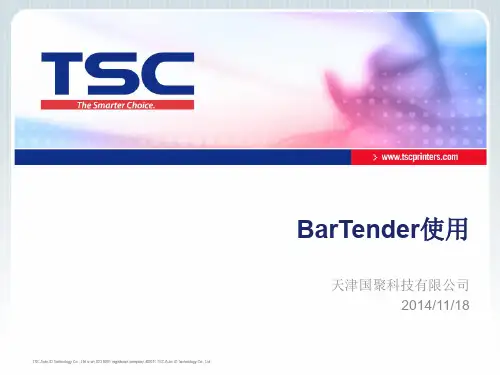
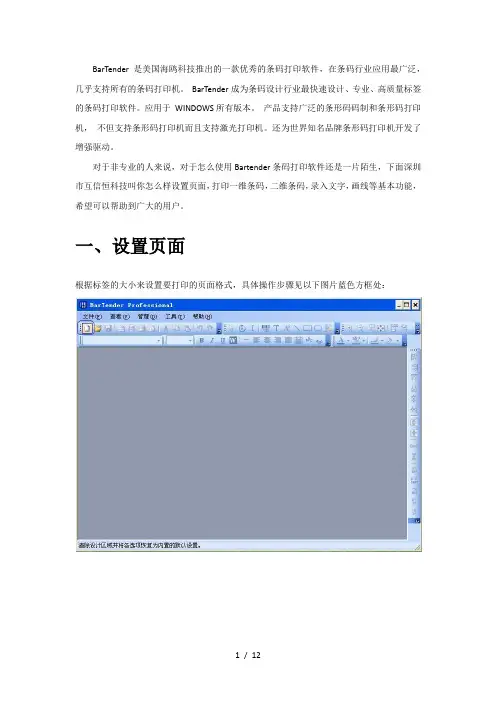
BarTender 是美国海鸥科技推出的一款优秀的条码打印软件,在条码行业应用最广泛,几乎支持所有的条码打印机。
BarTender成为条码设计行业最快速设计、专业、高质量标签的条码打印软件。
应用于WINDOWS所有版本。
产品支持广泛的条形码码制和条形码打印机,不但支持条形码打印机而且支持激光打印机。
还为世界知名品牌条形码打印机开发了增强驱动。
对于非专业的人来说,对于怎么使用Bartender条码打印软件还是一片陌生,下面深圳市互信恒科技叫你怎么样设置页面,打印一维条码,二维条码,录入文字,画线等基本功能,希望可以帮助到广大的用户。
一、设置页面根据标签的大小来设置要打印的页面格式,具体操作步骤见以下图片蓝色方框处:备注:创建页面后,需要先选择打印机,这里假设当前的打印机是TEC B-462-R,这样才方便进行后续的排版等操作。
设置的标签大小应该跟实际的标签大小一致,纸张因为有页边距,所以比实际大小要大一些!二、内容录入Bartender的界面录入以图形化为主,在工具栏上提供了一序列的模板,直接选择相应的模板后,然后再在下面的空白处点一下就可以创建相应的条形码,具体操作参考下面图片蓝色方框处:1、创建一维条形码2、创建二维条形码:备注:上面是选择相应的二维条形码码制,我们假设当前的二维码是当前用得最广泛的QC CODE条形码,选择该码制后,然后单击确定。
3、录入文本在工具栏上有一个”T”文本框,用鼠标点一下该处,然后再到下面的空白处点一下,这样就可以创建文本了,然后再下面的文本处再用鼠标点一下,用户就可以任意的输入文本了,具体操作参考如下图片蓝色方框处:、4、画线在工具栏上面有一个线条,点击该线条后就可以在下面的空白处直接画线了,参考下图6、打印创建完一个模板后,就是打印了,直接点击工具栏上的打印按钮,然后输入相应的打印份数,点打印就可以打印处相应的标签数量了。
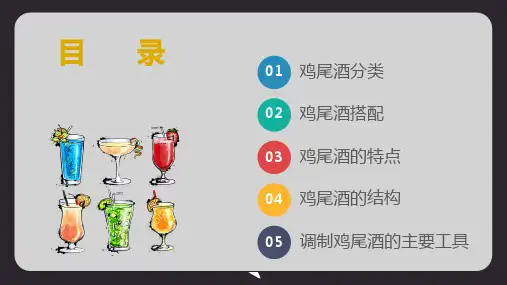
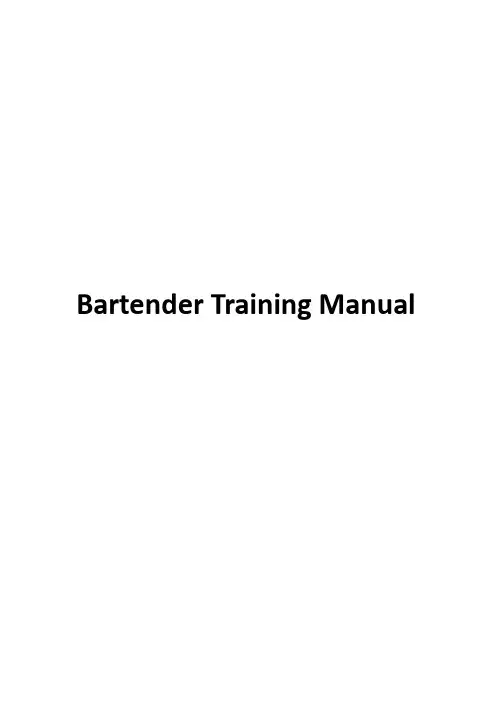
Bartender Training ManualTable of Contents INTRODUCTION (4)ALCOHOL AWARENESS (5)SANITATION (6)SAFETY (6)M AJOR CAUSE OF FOOD BORNE ILLNESS - (6)A LWAYS WASH YOUR HANDS AFTER YOU - (7)D ISPOSE OF WASTE PROPERLY - (7)K EEP INSECTS AND ANIMALS OUT BY - (7)H ANDLE ICE AND TABLEWARE PROPERLY - (7)A VOID CROSS CONTAMINATION FROM ONE FOOD ITEM TO ANOTHER - (7)S TORE FOODS AND EQUIPMENT PROPERLY - (7)W HEN CLEANING STATIONARY EQUIPMENT - (8)P REVENTING FALLS - (8)P REVENTING ELECTRIC SHOCK - (8)L IFT P ROPERLY - (8)M OVING A CART PROPERLY: (9)P REVENTING C UTS - (9)P REVENTING BURNS - (9)P REVENTING FIRES - (10)S AFE CHEMICAL HANDLING - (10)R EADING THE MSDS(M ATERIAL S AFETY D ATA S HEETS)- (10)THE GUEST (11)PERSONAL APPEARANCE (13)U NIFORM (13)SUGGESTIVE SELLING (14)THE GREETING (15)TAKING THE ORDER (15)REGISTER OPERATIONS (16)BAR STATION SETUP (17)T HE W ELL (17)BACK STATION SETUP (17)H OT D RINK S TATION (17)ORDERING PROCEDURES (18)C ATEGORY (18)A BBREVIATIONS (18)S ERVING O RDER (18)S ERVICE S YSTEM (18)PREPARING DRINK ORDERS (19)D ELIVERING AND S ERVING D RINKS (19)SERVICE TIME (21)LIQUOR LAWS (21)SERVICE WELL (22)D RINK B ASICS (22)STANDARDIZATION OF BEVERAGE ORDERS (24)P REPARING D RINKS (24)GLASSWARE (25)ICE (26)DRINK MAKING TECHNIQUES (26)GARNISHES (29)CLOSING OUT A TABLE (30)P RESENTING THE C HECK (31)T HE F AREWELL (31)M ETHODS OF P AYMENT (32)OPENING, RUNNING, CLOSING DUTIES (32)BAR CLEANLINESS (33)END OF SHIFT RESPONSIBILITIES (34)BARTENDER SECURITY RESPONSIBILITIES (34)CHECK OUT PROCEDURES (35)O VER R INGS O R V OIDS (35)H OUSE P ROMO (36)M ANAGER P ROMO (36)E MPLOYEE D ISCOUNT/C USTOMER D ISCOUNT (36)TIP POOL (37)PERFORMANCE STANDARDS (38)FRONT OF THE HOUSE BEHAVIOR (40)CONCLUSION (41)IntroductionCongratulations on your employment as a bartender at [Restaurant Name]! We will provide you with the training you need to be successful. As a bartender you'll be an important part of each guest's experience in our restaurant. We take great pride in our quality beverages and friendly, responsive service. Our high standards can only be maintained through great people like you who share our values and desire to do the very best job possible for our guests every day. The guidelines listed on the following pages have been established to help you in your effort to provide these qualities to our guests. Along with the hands-on training you will receive, this manual will provide answers to questions you may have regarding the operating procedures for [Restaurant Name].C.A.R.E.S.◎ C ustomers are our focus◎ A ttitude affects everything◎ R espect others-have fun◎ E arn profits for everyone◎ S ervice is EVERYTHING!Once again, welcome to the [Restaurant Name] Team!Alcohol AwarenessAlcohol Awareness is a growing concern within the Hospitality Industry nationwide. By recognizing the "early" signs of intoxication, monitoring your customer's consumption, and treating them as you would a guest in your own home; you fulfill your responsibility and protect the guest.To serve or not to serve?By understanding and fulfilling your responsibilities...Your Role:◎Observe◎Monitor◎ReportAssisted by the guidance and support of management...Your Manager's Role:◎Confirm◎Confront◎ResolveWith adherence to the company's policies...1. We will not knowingly serve alcohol to an obviously intoxicated or underage customer.2. We will offer alternatives to alcohol.3. We will create an atmosphere to promote responsible drinking.4. We will make a reasonable attempt to prevent obviously intoxicated customers from driving.. . . We can accurately and confidently answer that very important question.◎Responsible service of alcohol requires a team effort.◎Know and watch for the signs of intoxication. If there is any question, avoid further service and report to a manager who will make the final decision and determine whether the guest should remain or leave.◎If you know what it takes to get someone drunk, you can prevent it by monitoring their consumption and offering alternatives.◎Do not allow drunks to come in, and do not allow intoxicated guests to drive. ◎Hospitality is our business. Beverage service is only one element.◎Cooperation between employees and management allows us to exercise a degree of influence on the behavior of our customers that will result in anatmosphere of responsible drinking.◎This is just a portion of our company Alcohol Awareness program.A complete handbook with certification test is provided at orientation.SanitationThe responsibility of management and staff to protect the public from food borne illness is fundamental. A food borne illness is simply a disease that is carried, or transmitted, to human beings by food.Throughout your training, you will receive information concerning proper temperatures of food storage and serving, as well as, cleanliness standards, proper use of chemical cleaning, and disinfectant products. It is our objective to operate the restaurant at the highest level of cleanliness and sanitation for the benefit of our customers and employees.SafetyIn addition to a clean and sanitary environment, the [Restaurant Name]provides a safe environment. One of our goals here at the [Restaurant Name] is to operate an accident-free restaurant. A safe restaurant takes teamwork and effort on everyone's part. Everyone who works with cleaning chemicals will receive training on the use of those products, and will be tested following the guidelines of China Hazard Communication Standard.Safety meetings will also be used to review information presented from the initial training. Management's role is to provide the daily monitoring of safe work practice developed from these meetings.Whenever you see a potential hazard, or something you notice as unsafe, notify a manager immediately.Below is a list of guidelines to follow for safety and sanitation:Major cause of food borne illness -◎Food left in the danger zone of 5°C to 60°C for four or more hours. Keep all foods out of the danger zone of 5°C to 60°C.◎Keep hot foods hot, and cold foods cold.◎Handle foods quickly during delivery, and put refrigerated and frozen foods away as soon as possible.◎Sloppy personal hygiene habits will not be tolerated.◎Do not prepare food a day or more before serving.◎Do not serve food that is not completely cooked.◎Thaw foods in refrigerator, microwave, or under cold running water for not more than 2 hours, followed immediately by cooking.◎Avoid preparing food in advance, unless absolutely necessary.◎Inspect Foods thoroughly for freshness and wholesomeness upon receipt, cooking, and serving.◎Only use sanitized equipment and table surfaces.Always wash your hands after you -◎Smoke, eat, use the restroom; touch money, raw foods, or your face, hair or skin;cough, sneeze, or blow your nose◎Comb your hair, handle anything dirty◎Before and after taking a breakDispose of waste properly -◎Take garbage out frequently.◎Keep garbage areas clean and sealed.◎Clean and sanitize garbage cans regularly.◎Store soiled linen in a laundry bag or non-absorbing container.Keep insects and animals out by -◎Keeping doors closed.◎Taking garbage out frequently and keeping garbage areas clean.◎Report any holes where an animal can enter.◎Do not provide a free meal for any animals.Handle ice and tableware properly -◎Use clean scoops or tongs to pick up ice, do not use hands or glass.◎Store scoops or tongs in a clean container, not in the ice.◎Do not store any food or beverage in the ice.◎Avoid touching food contact surface with dishes, utensils, etc.Avoid cross contamination from one food item to another -◎Keep separate cutting boards for raw and cooked foods.◎Never mix leftovers with fresh food.◎Store fresh raw meats, poultry, and fish on lowest racks.◎Sanitize thermometers after each use.◎When thawing raw foods in the refrigerator, place them on the lowest shelf. Store foods and equipment properly -◎Cover, label, and date foods in storage.◎Do not store food in open cans.◎Store new foods behind old ones.◎Store food off the floor and away from the wall.◎Check temperatures of refrigerators and freezers daily.◎Defrost freezers as necessary. Frost build up causes freezers to warm up.◎Dry goods and storage areas should be cool and dry for good storage.◎Do not store food or equipment under exposed server lines.◎Keep storage areas clean.◎Store all equipment so that dust cannot settle on it.◎Store chemicals and pesticides separately from food.When cleaning stationary equipment -◎Unplug equipment, and make sure hands are dry.◎Disassemble.◎Wash removable parts in dish machine, or three-compartment sink.◎Wash and rinse stationary parts.◎Sanitize food contact surfaces with sanitizer.◎Air dry before reassembling, without touching food contact surfaces. Preventing falls -◎Wipe up spills immediately.◎Use "wet floor" signs.◎Wear shoes with non-skid soles and heels.◎Keep isles.◎Walk, and do not run.◎Follow established traffic patterns.◎Do not carry anything that blocks your vision.◎Keep drawers closed.◎Use ladders properly; never use chairs, tables or boxes. Do not stand on top of ladder, and do not over reach.◎Turn lights on to see.◎Never run in the kitchen. The floor may be wet.◎Never leave anything on the floor including ice from the ice machine. Preventing electric shock -◎Never touch electrical equipment with wet hands, or while standing in water.◎Unplug equipment before cleaning or disassembling, to avoid shock.◎Do not yank plugs out by cord. This can cause damage to the cords, which may then cause shocks.◎Report damaged and worn plugs and cords to your supervisor.Lift Properly -◎Plan it. Do you need help? Could you use a cart? Where is it going? Which route is best?◎Get ready. Spread feet apart, shoulder width. Put one food slightly in front of the other for a good support base. Squat down with back straight and head up. Do not bend over from the waist! Grip the object firmly with both hands. Keepelbows and arms close to body.Tuck in chin. If lifting a tray, squat down alongside the tray and slide the tray intoyour shoulder and hand.◎Lift it! Straighten your knees slowly and smoothly to a stand. Avoid doing this in a quick or jerky manner. Do not lift and twist at the same time.◎Move it! Keep object close to you. To change position, move your feet and entire body. Do not twist from the waist. Look where you are going and call out"coming through" as needed.◎Set it down! Bend your knees slowly and smoothly. Slide load into place; watch your fingers and toes.Moving a cart properly:◎Push rather than pull.◎Spread feet wide, one in front of the other with your front knee bent.◎Keep back straight.◎Slowly push into the cart with your body weight, using your leg muscles to do much of the pushing.◎Push slowly and smoothly. Avoid sudden motions or twisting your back. Preventing Cuts -◎Know how to operate equipment.◎Pay attention when using sharp equipment. Never touch edges of sharp blades. ◎Use guards when provided on equipment.◎Use tampers to push food into equipment.◎Turn equipment off before adjusting.◎No loose sleeves, ties, or dangling jewelry should be by equipment◎Use knives carefully.◎Carry dishes and glassware carefully.◎Sweep up broken glass; do not use your hands.◎Use special container to dispose of broken glass, dishes, and other sharp objects. ◎Remove can lids entirely from cans, then dispose of them.Preventing burns -◎Pay attention when working around hot equipment.◎Use dry potholders or towels when handling hot equipment. Wet or moist towels will serve as conductors of heat.◎Keep pot handles turned in from the edge of the range and open flames.◎Avoid overfilling containers with hot foods.◎Get help lifting heavy pots of hot foods.◎Open lids of pots and doors of streamers away from you, and do so slowly, to avoid a steam burn.◎Stir foods with long-handled spoons.◎Warn others of hot surfaces.◎Let equipment cool before cleaning, and do not use wet rags.◎Do not put icy frozen foods into the fryer. Put foods slowly into the fryer andstand back to avoid being splattered.◎Strike match before turning on gas equipment, to avoid a flare-up.◎Wear closed-toe and closed-heel shoes that do not absorb liquids.◎Warn guest of hot dishes.Preventing fires -◎Smoke only where allowed.◎Do not turn your back on hot fat, as it may burst into flames.◎Keep equipment and hoops from grease build up because grease causes many food service fires.◎Do not set the fryer at too high a temperature.◎Store matches in a covered container, away from heat.◎Keep garbage in covered container, away from heat.◎Store chemicals away from heat because many chemicals are flammable.Safe chemical handling -◎Do know where the material safety data sheets are posted, and read them.◎Do read the labels of all products, before you use them.◎Do follow the directions for proper storage, handling, and use for all chemicals you use.◎Do ask your supervisor any questions or concerns you may have about using a certain products.◎Do know how to call for medical help, in case of an emergency.◎Do not ever mix chemicals together.◎Do not store chemicals in unmarked containers.◎Do not store chemicals in or close to food storage, preparation, or serving areas. ◎Do not leave aerosol spray containers near heat or spray close to an open flame. ◎Do not dispose of any empty chemical container until you have checked on the label for how to do so.Reading the MSDS (Material Safety Data Sheets) -◎Read product name.◎Fire hazard - explains if the product can catch fire or explode.◎Health hazards - explains effects of over exposure and first aid procedures.◎Spill precautions explains steps to take in case of spills.◎Special protection - describes any special measures, such as goggles and rubber gloves, used to decrease exposure and risk.The GuestNever underestimate the importance of a guest!!!◎A guest is not dependent upon us -- we are dependent upon him (or her).◎A guest is NEVER an interruption of our work - he is the purpose of it.◎A guest does us a favor when he comes here -- we are not doing him a favor by serving him.◎A guest is part of our business -- not an outsider.◎A guest is not a cold statistic -- he is a flesh and blood human being with feelings and emotions, like our own.◎A guest is a person who brings us his wants -- it is our job to fill those wants.◎A guest is deserving of the most courteous and attentive treatment we can give him.◎A guest is the lifeblood of the [Restaurant Name]You Must Be Able To Serve Many Different Types Of GuestsTo make appropriate selling suggestions, and give good service, it is helpful to recognize and know how to handle all types of guests. For exampleThe Timid Guest:Genuine interest and patient understanding will put this type of guest at ease. Even a comment on the weather can make him feel at home.The Aggressive Guest:This type must be handled in a courteous and businesslike manner. Kindness and politeness can often change him into a steady and appreciative customer.The Fussy Guest:This is one of the hardest guests to please. Try to stay one step ahead of him by learning the things that irritate him. Be sure to have everything just right, before serving the fussy guest.Remember all of the little things the fussy guest especially likes, even when they may seem peculiar to the average person.The Over-Familiar Guest:Be courteous, dignified, and avoid long conversations. Stay away from the table, except when actual service is needed. Never try to give a wise crack answer to a smart remark. You will only cheapen yourself and lower yourself to the same level as the rudeness of the guest.The Guest who is Alone:Don't call attention by asking if he is alone. Seat him where he can see what is going on. The guest may be lonely and want someone to talk to. Be friendly, but don't neglect other guests. With nobody to talk to, time seems long, so serve as quickly as possible. This could be your most critical guest.The Noisy Trouble-maker:Don't be drawn into arguments. Speak softly. Don't antagonize. Refuse to participate in criticism of management, the establishment, or other personnel.The Blind Guest:Seat blind people with a dog so that the dog will not be noticed. Never hover over blind customers. Always stand near enough to help if needed. Always make a blind customer feel appreciated and important.Guest with hand or arm injuries/disability:Seat as quickly as possible. Be helpful, ask if you may assist them, but do not be too eager. Be considerate; do not call attention by hovering. Seat wheelchair guests at a table that does not block an aisle. Always make a disabled guest feel important and accommodated.I Am Your Guest"You often accuse me of carrying a chip on my shoulder, but I suspect this is because you do not entirely understand me. Isn't it normal to expect satisfaction for one's money spent? Ignore my wants and I will no longer appear in your restaurant. Satisfy those wants and I will become increasingly loyal. Add a little extra personal attention and a friendly touch and I will become a walking advertisement for you." "When I criticize your food and service to anyone who will listen, which I may do whenever I am displeased, take heed. I am not dreaming up displeasure. It lies in something I perceive you have failed to do to make my eating experience as enjoyable as I have anticipated. Eliminate that perception or you will lose my friends and me as well. I insist on the right to dine leisurely or eat in haste according to my mood.""I refuse to be rushed as I abhor waiting. This is an important privilege that my money buys. If I am not spending big money this particular time, just remember, if you treat me right I will return with a larger appetite, more money and probably with my friends.""I am much more sophisticated these days than I was just a few years ago. I've grown accustomed to better things and my needs are more complex. I'm perfectly willing to spend, but I insist on quality to match prices. I am above all, a human being. I am especially sensitive when I am spending money. I can't stand to be snubbed, ignored or looked down upon." "Whatever my personal habits may be, you can be sure that I'm a real nut on cleanliness in restaurants. Where food is concerned I demandthe strictest sanitation measures. I want my meals handled and served by the neatest of people and in sparkling clean dishes. If I see dirty fingernails, cracked dishes or soiled table clothes you won't see me again.""You must prove to me again and again that I have made a wise choice in selecting your restaurant above others. You must convince me repeatedly that being a restaurant guest is a desirable thing in the first place. I can, after all, eat at home. So, you must provide something extra in food and service. Something so superior it will beckon me from my own table to yours. Do we understand each other?"Personal AppearanceYour overall image is our image. You make a distinct impression on each of our guests. The image you create can enhance or detract from our overall concept and the way our Restaurant is perceived in the minds of the guest. You are entrusted with handling our guests' needs and must, therefore, reflect cleanliness and wholesomeness at all times.Always remember . . .◎You are responsible for keeping your clothing neat and clean at all times. There is no excuse for reporting to work out of dress code.◎Do not wear scented lotion on your hands, as it clings to glassware.◎A smile is part of your dress attire.◎At no time will employees chew gum or eat while in the public areas of our store. ◎Do not report to work wearing un-pressed or dirty clothing, or unkempt hair. UniformWhen you walk through the door of the Restaurant, "YOU ARE ON.”You will be informed of the dress requirements when you start with us. Your dress attire also includes a CONTAGIOUS, ENTHUSIASTIC ATTITUDE. You are required to enter the building for your shift in FULL DRESS ATTIRE. You are also required, when you leave the building, to be in FULL DRESS ATTIRE.Your dress attire also includes the following, without exception:◎At least two pens◎Bottle/Wine Opener◎Bank◎SmileDining Room / Bar Dress Code◎Shoes - Black shoes only with non-slip soles that permit walking safely on wet or greasy floors. Shoes must be clean. Socks must be dark, preferably black.◎Pants & Belts - Black pants only. Pants must be long enough to touch the top of the shoe. Solid color black belts must be worn with pants that have belt loops. ◎Shirts - Oxford style, long sleeve white dress shirts. Shirts must be in good condition, not soiled or stained. Shirts must fit at the sleeve.◎Appearance - Clean and well groomed hair. Hair pulled back off the shoulder.Well-groomed hands, fingernails and fingernail polish. Facial hair should be neat and well trimmed.◎Accessories - No excessive cologne, perfume, make-up or jewelry.No earrings longer than 1 inch. No hat or unauthorized buttons can be worn.◎Apron –Black, waist tie with pockets.Suggestive SellingSelling is a part of everyone's life. You had to sell the [Restaurant Name] Management Team on your ability as a bartender. Our customer is "sold" on [Restaurant Name] before they come in. If they enjoy themselves, chances are they will return and "sell" us to someone else.People don't like to be "SOLD." Effective suggestive selling is subtle.You are doing the guest a favor, looking after his best interests by offering your knowledge and expertise and making honest recommendations.Many of our guests are not familiar with our daily specials. As their intermediary, you are in the position to smooth the way for a confused guest. Above all, be sincere and honest. Always do what you truly believe is in the "guest's" best interest.Recommend items you know are superior and you are certain they will enjoy. NEVER OVER SELL! Always allow the guest to finish ordering before you start suggesting.Be aware of what the guest is ordering and make sure he understands what he is getting.Read your guests and suggest appropriate cocktails:◎ On a chilly evening, "Would you like to try a Irish Coffee?"◎ To businessmen, "Would you care for a Martini or Whisky on the rocks?"◎ With party people, "How about a Long Island Iced Tea or a Margarita?"◎ An older couple, "Would you like a Manhattan or some Baileys Irish Cream?"◎ You can also suggest beverages made with your guest's favorite liquor or up sell our premium house wine to guests preferring house wine by the glass. If guests seem to be in a hurry, suggest that they eat at the bar, instead of waiting for a table. Busy lunch shifts are a great time to greet guests and invite them to have lunch at your bar.Do not confuse suggestive selling with overloading your guests with beverages or food. Your goal is a satisfied guest who enjoyed their experience and wants to return.The GreetingYour greeting is the first impression given to the customer, so strive to make it special. Always greet the guest with a smile, a welcome, and your name. Demonstrate some aspect of your personality. Change it around: using the same greeting every time sounds mechanical.Approach your guest(s) as soon as possible. If you can't get to a new guest within 30 seconds, be sure that you at least acknowledge them by eye contact and verbal contact. The first thought going through a guest's mind is, "Am I going to be waited on?" You can notice the person visibly relax when you say, "I'll be right with you." Taking the OrderWhen approaching a guest for a drink order, always place a napkin in front of each guest. This alerts management and fellow bartenders that the guest has been take care of. When taking orders, make a mental note of the guest's face. Maintain eye contact when addressing guests in order to prevent mistakes and to communicate effectively. Never ask for a drink order in a manner, which can be answered “yes”,or "no." You are much more than an order taker: you are a salesperson.We expect you to sell our products and satisfy the customer's needs.Customer satisfaction provides the opportunity to build repeat business and establish regular clientele that, allows you to be successful.A prerequisite of selling is the knowledge of our products and prices. If a guest does not specify a brand of liquor, it is our policy to offer a beverage by brand name. This technique is referred to as "up-selling." Up-selling requires thorough knowledge of the products available in order to be effective: i.e., the customer says, "I'll have a vodka tonic." The bartender responds, "Would you like Absolut or Ketel One?" A good approach to have when taking orders from a couple is to ask for the lady's order first. Repeat the order to the customer.Ask whether the cocktails will be paid for in cash or if the guest would like to run a tab on a credit card. Obtain the credit card before leaving the guest to save time. If one person does the ordering for several people, that person is usually the customer who will be paying; direct your questions to this person.Never assume one person is paying for the entire round, or that the same person is buying the next round. When in doubt, ASK! Assure the guests that you will be right back with their cocktails. Check the ashtrays and cocktail napkins for changing, if necessary.◎ Always thank the guest after every transaction and assure them of your continued service: "I'll be back in a few minutes to see if you need a refill."◎ Always check the ashtray and table cleanliness.Ashtrays must be capped, emptied, and wiped before being returned in front of acustomer." One cigarette butt is enough, two is too many.” Be highly attentive to this motto.Register Operations(Sometime this job require a cashier)You will receive training on our computerized register system. It is equipped with imprinters that will send food items to the kitchen and bar items to the bar. The register system imprints time of order, bar seat number, and date. It is extremely important that you fully understand the register operations, to eliminate food or beverages going out at wrong times and to the wrong tables; and, wrong food being made and sent out.This system will also allow you to close out methods of payment for cash or credit cards. This system is designed for the server's ease and comfort, and enables them to remain on the floor and in their stations.It is important for the server to be fluent in register operations for many reasons: ◎ Organization and speed in the kitchen◎ Waste control◎ Expedience◎ The best customer service and experience。